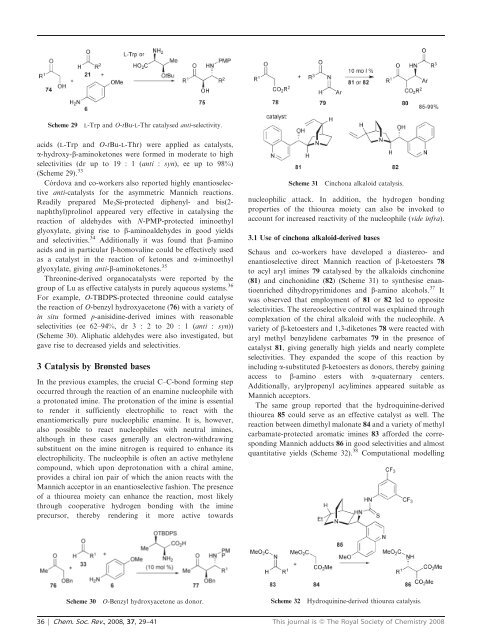Organocatalysed asymmetric Mannich reactions
Organocatalysed asymmetric Mannich reactions
Organocatalysed asymmetric Mannich reactions
Create successful ePaper yourself
Turn your PDF publications into a flip-book with our unique Google optimized e-Paper software.
Scheme 29<br />
L-Trp and O-tBu-L-Thr catalysed anti-selectivity.<br />
acids (L-Trp and O-tBu-L-Thr) were applied as catalysts,<br />
a-hydroxy-b-aminoketones were formed in moderate to high<br />
selectivities (dr up to 19 : 1 (anti : syn), ee up to 98%)<br />
(Scheme 29). 33<br />
Córdova and co-workers also reported highly enantioselective<br />
anti-catalysts for the <strong>asymmetric</strong> <strong>Mannich</strong> <strong>reactions</strong>.<br />
Readily prepared Me 3 Si-protected diphenyl- and bis(2-<br />
naphthyl)prolinol appeared very effective in catalysing the<br />
reaction of aldehydes with N-PMP-protected iminoethyl<br />
glyoxylate, giving rise to b-aminoaldehydes in good yields<br />
and selectivities. 34 Additionally it was found that b-amino<br />
acids and in particular b-homovaline could be effectively used<br />
as a catalyst in the reaction of ketones and a-iminoethyl<br />
glyoxylate, giving anti-b-aminoketones. 35<br />
Threonine-derived organocatalysts were reported by the<br />
group of Lu as effective catalysts in purely aqueous systems. 36<br />
For example, O-TBDPS-protected threonine could catalyse<br />
the reaction of O-benzyl hydroxyacetone (76) with a variety of<br />
in situ formed p-anisidine-derived imines with reasonable<br />
selectivities (ee 62–94%, dr 3 : 2 to 20 : 1 (anti : syn))<br />
(Scheme 30). Aliphatic aldehydes were also investigated, but<br />
gave rise to decreased yields and selectivities.<br />
3 Catalysis by Brønsted bases<br />
In the previous examples, the crucial C–C-bond forming step<br />
occurred through the reaction of an enamine nucleophile with<br />
a protonated imine. The protonation of the imine is essential<br />
to render it sufficiently electrophilic to react with the<br />
enantiomerically pure nucleophilic enamine. It is, however,<br />
also possible to react nucleophiles with neutral imines,<br />
although in these cases generally an electron-withdrawing<br />
substituent on the imine nitrogen is required to enhance its<br />
electrophilicity. The nucleophile is often an active methylene<br />
compound, which upon deprotonation with a chiral amine,<br />
provides a chiral ion pair of which the anion reacts with the<br />
<strong>Mannich</strong> acceptor in an enantioselective fashion. The presence<br />
of a thiourea moiety can enhance the reaction, most likely<br />
through cooperative hydrogen bonding with the imine<br />
precursor, thereby rendering it more active towards<br />
Scheme 31<br />
Cinchona alkaloid catalysis.<br />
nucleophilic attack. In addition, the hydrogen bonding<br />
properties of the thiourea moiety can also be invoked to<br />
account for increased reactivity of the nucleophile (vide infra).<br />
3.1 Use of cinchona alkaloid-derived bases<br />
Schaus and co-workers have developed a diastereo- and<br />
enantioselective direct <strong>Mannich</strong> reaction of b-ketoesters 78<br />
to acyl aryl imines 79 catalysed by the alkaloids cinchonine<br />
(81) and cinchonidine (82) (Scheme 31) to synthesise enantioenriched<br />
dihydropyrimidones and b-amino alcohols. 37 It<br />
was observed that employment of 81 or 82 led to opposite<br />
selectivities. The stereoselective control was explained through<br />
complexation of the chiral alkaloid with the nucleophile. A<br />
variety of b-ketoesters and 1,3-diketones 78 were reacted with<br />
aryl methyl benzylidene carbamates 79 in the presence of<br />
catalyst 81, giving generally high yields and nearly complete<br />
selectivities. They expanded the scope of this reaction by<br />
including a-substituted b-ketoesters as donors, thereby gaining<br />
access to b-amino esters with a-quaternary centers.<br />
Additionally, arylpropenyl acylimines appeared suitable as<br />
<strong>Mannich</strong> acceptors.<br />
The same group reported that the hydroquinine-derived<br />
thiourea 85 could serve as an effective catalyst as well. The<br />
reaction between dimethyl malonate 84 and a variety of methyl<br />
carbamate-protected aromatic imines 83 afforded the corresponding<br />
<strong>Mannich</strong> adducts 86 in good selectivities and almost<br />
quantitative yields (Scheme 32). 38 Computational modelling<br />
Scheme 30<br />
O-Benzyl hydroxyacetone as donor.<br />
Scheme 32<br />
Hydroquinine-derived thiourea catalysis.<br />
36 | Chem. Soc. Rev., 2008, 37, 29–41 This journal is ß The Royal Society of Chemistry 2008
















